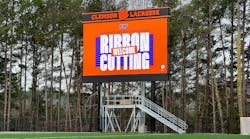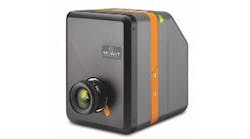As LED luminaires became more and more popular in the market, but at the same time, we found that some LED luminaires doesn’t work after lightning strike test, specially for outdoor LED street lamp. The main reason caused this is these LED luminaires can’t pass the EMS lighting surge test, to solve this problem, Lisun Electronics Shanghai office developed new designed SG61000-5 lighting surge tester.
The main technical specification of SG61000-5 as below:
The SG61000-5 lighting surge generator output voltage range is 0~6KV±10%, the output current range is 0~3KA±10%; the output voltage(Open) waveform is 1.2/50us±20%, the output current(Short) waveform is 8/20us±20%; the output impendence is 2? and it have included a 16A single phase CDN(Coupling and Decoupling Network).
The SG61000-5 application with big LCD touch screen, it has build in Windows CE operate system, you can control this device by touch screen. Comparing with traditional device, it can use much longer and more convenient for customer, because when you use traditional device, you need push buttons one by one and after long time, these push buttons will be invalid even will be broken, bur new designed lighting surge tester can avoid this problem and higher efficient.
Besides above new adoption technology, the SG61000-5 lighting surge tester has built-in voltage probe, when you want see voltage and current waveform, you can use a digital oscilloscope connect it directly. Comparing with traditional lighting surge tester, you needn’t purchase extra voltage probe and others components.
Test Method?
Surges are caused by over voltages from switching and lightning transients. And the purpose for surge immunity test is that build a common criterion to evaluate the performance of electric and electronic equipments suffer from surge shock. According to IEC61000-4-5 Testing and Measurement Techniques – Surge immunity test, the surge generator should be simulation the waveform of 1.2/50us voltage wave, 8/20us current wave and combination wave (voltage wave: 10/700us; current wave: 5/320us), and then coupling the wave to tested circuit to achieve the experimental purpose. The test levels include class 1, class 2, class 3, class 4 and class X; among them, X is open level. And each level has its corresponding voltage strength, like table 1. And the test level depends on the environment and installation condition, classified as below:
The main technical specification of SG61000-5 as below:
The SG61000-5 lighting surge generator output voltage range is 0~6KV±10%, the output current range is 0~3KA±10%; the output voltage(Open) waveform is 1.2/50us±20%, the output current(Short) waveform is 8/20us±20%; the output impendence is 2? and it have included a 16A single phase CDN(Coupling and Decoupling Network).
The SG61000-5 application with big LCD touch screen, it has build in Windows CE operate system, you can control this device by touch screen. Comparing with traditional device, it can use much longer and more convenient for customer, because when you use traditional device, you need push buttons one by one and after long time, these push buttons will be invalid even will be broken, bur new designed lighting surge tester can avoid this problem and higher efficient.
Besides above new adoption technology, the SG61000-5 lighting surge tester has built-in voltage probe, when you want see voltage and current waveform, you can use a digital oscilloscope connect it directly. Comparing with traditional lighting surge tester, you needn’t purchase extra voltage probe and others components.
Test Method?
Surges are caused by over voltages from switching and lightning transients. And the purpose for surge immunity test is that build a common criterion to evaluate the performance of electric and electronic equipments suffer from surge shock. According to IEC61000-4-5 Testing and Measurement Techniques – Surge immunity test, the surge generator should be simulation the waveform of 1.2/50us voltage wave, 8/20us current wave and combination wave (voltage wave: 10/700us; current wave: 5/320us), and then coupling the wave to tested circuit to achieve the experimental purpose. The test levels include class 1, class 2, class 3, class 4 and class X; among them, X is open level. And each level has its corresponding voltage strength, like table 1. And the test level depends on the environment and installation condition, classified as below:




